Rainforests, the verdant jewels of our planet, captivate the imagination with their lush canopies, teeming with life and rich with biodiversity. These magnificent ecosystems, found in equatorial regions across the globe, hold secrets and wonders yet to be fully discovered. In their emerald realms, a symphony of vibrant colours, exotic flora, and extraordinary fauna intertwine. Rainforests are not merely breathtaking natural wonders; they are vital pillars of our planet’s health. With their unparalleled ability to sequester carbon, regulate the water cycle, and harbour countless species, rainforests play an irreplaceable role in maintaining climate balance and safeguarding the very fabric of life on Earth. In this article, we delve into the enchanting realm of rainforests, exploring their intricate ecosystems and highlighting their critical significance in our rapidly changing world.
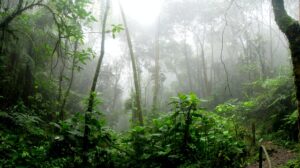 Rainforests:
Rainforests:
Rainforests are lush and biodiverse ecosystems found near the equator. They are characterized by heavy rainfall and dense vegetation. These magnificent forests are home to a staggering variety of plant and animal species, making them vital centres of biodiversity. Rainforests play a crucial role in the Earth’s climate regulation by sequestering carbon dioxide and producing oxygen. They also contribute to the water cycle by absorbing rainfall and preventing soil erosion. Unfortunately, rainforests face significant threats from deforestation, logging, and climate change, endangering their delicate balance. Protecting and preserving these invaluable ecosystems is essential for the well-being of our planet and future generations.
Amazon Rain Forest:
The Amazon Rainforest, spanning several South American countries, is the largest tropical rainforest on Earth. Encompassing approximately 5.5 million square kilometres (2.1 million square miles), it is a biodiversity hotspot of immense importance. The Amazon Rainforest is home to an astonishing array of plant and animal species, many of which are still being discovered. Its dense foliage and winding rivers are inhabited by iconic creatures like jaguars, sloths, and toucans.
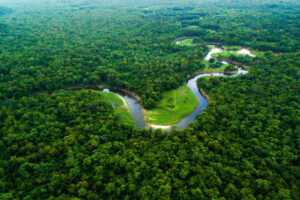
Beyond its rich biodiversity, the Amazon Rainforest plays a vital role in the global ecosystem. It acts as a massive carbon sink, absorbing and storing vast amounts of carbon dioxide, thus mitigating climate change. Moreover, it regulates regional and global weather patterns and influences rainfall patterns across South America.
Sadly, the Amazon Rainforest faces significant threats, primarily from deforestation, agriculture, mining, and illegal logging. These activities not only lead to the loss of precious habitats but also contribute to greenhouse gas emissions and the disruption of indigenous communities way of life.
Efforts to protect and preserve the Amazon Rainforest are crucial for the well-being of the planet. Sustainable practices, conservation initiatives, and the involvement of local communities and international cooperation are essential to safeguard this extraordinary ecosystem for future generations.
Congo Rain Forest:
The Congo Rainforest, situated in Central Africa, is the second-largest tropical rainforest in the world. Encompassing approximately 1.8 million square kilometres (700,000 square miles), it spans across the Democratic Republic of Congo, the Republic of Congo, and other neighbouring countries. This biodiverse ecosystem is renowned for its incredible array of flora and fauna, including gorillas, chimpanzees, and forest elephants.

The Congo Rainforest plays a critical role in maintaining regional and global climate stability. It acts as a carbon sink, absorbing significant amounts of carbon dioxide, and helps regulate the Earth’s climate patterns. The forest’s vast expanse and dense vegetation contribute to the preservation of watersheds, supporting local communities access to clean water and sustaining a wealth of ecological services.
Unfortunately, the Congo Rainforest faces numerous threats, including deforestation, illegal logging, mining, and encroachment. These activities disrupt the delicate balance of the forest, endangering its biodiversity and the livelihoods of indigenous communities. Efforts to protect and sustainably manage the Congo Rainforest are crucial for biodiversity conservation, climate change mitigation, and the well-being of local populations.
The Daintree Rainforest:
The Daintree Rainforest, situated in Queensland, Australia, is a remarkable and ancient ecosystem that holds a special place in the natural heritage of the country. Spanning over 1,200 square kilometres (460 square miles), it is one of the oldest rainforests on Earth, dating back over 180 million years. The Daintree Rainforest is renowned for its extraordinary biodiversity, housing an astonishing variety of plant and animal species, including rare birds like the southern cassowary and unique mammals like the tree kangaroo.

What sets the Daintree Rainforest apart is its pristine beauty and remarkable landscapes. Towering trees, lush foliage, crystal-clear streams, and hidden waterfalls create a magical and enchanting atmosphere. The rainforest is also home to the breathtaking Mossman Gorge, where visitors can immerse themselves in the serenity of ancient ferns and freshwater pools.
However, the Daintree Rainforest faces threats from habitat fragmentation, climate change, and invasive species. Efforts have been made to preserve this precious ecosystem, including the establishment of the Daintree National Park and various conservation initiatives. Sustainable tourism practices and educational programs are also in place to raise awareness about the importance of protecting this unique rainforest for future generations to cherish and enjoy.
Borneo Rainforest:
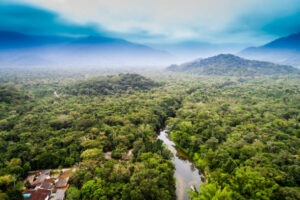
The Borneo Rainforest, which spans Indonesia, Malaysia, and Brunei, is a magnificent haven of biodiversity and natural marvels. It stands as one of the oldest rainforests on our planet, renowned for its stunning variety of plant and animal species. Among its inhabitants are the iconic orangutans, pygmy elephants, probosci’s monkeys, and the elusive Bornean clouded leopard. The rainforest’s dense canopies and meandering rivers create a breathtaking landscape of unparalleled beauty. However, the Borneo Rainforest faces pressing threats from destructive practices like deforestation for palm oil plantations, illegal logging, and the fragmentation of habitats. Urgent conservation measures are essential to safeguard this invaluable ecosystem and ensure the survival of its unique flora and fauna for generations to come.
Sumatra Rainforest:
The Sumatra Rainforest, located in Indonesia, is a remarkable and biologically rich ecosystem that deserves attention and conservation efforts. It is one of the last remaining expanses of tropical rainforest in Southeast Asia, renowned for its incredible biodiversity and unique species.
 The rainforest of Sumatra is home to critically endangered species, including the Sumatran tiger, Sumatran orangutan, and Sumatran rhinoceros. It also houses a wide range of flora, such as the towering Dipterocarp trees and the giant Rafflesia flower, which holds the title of the world’s largest individual flower.
The rainforest of Sumatra is home to critically endangered species, including the Sumatran tiger, Sumatran orangutan, and Sumatran rhinoceros. It also houses a wide range of flora, such as the towering Dipterocarp trees and the giant Rafflesia flower, which holds the title of the world’s largest individual flower.
The Sumatra Rainforest not only supports an exceptional variety of wildlife but also plays a crucial role in maintaining the region’s climate and hydrological systems. It serves as a carbon sink, absorbing and storing significant amounts of carbon dioxide, and helps regulate rainfall patterns.
Unfortunately, the Sumatra Rainforest is under severe threat from illegal logging, land conversion for agriculture, and palm oil plantations. These activities contribute to deforestation, habitat loss, and the degradation of this precious ecosystem.
Conservation initiatives are essential to protect the Sumatra Rainforest and its unique species. Efforts are being made to establish protected areas, promote sustainable land-use practices, and raise awareness about the importance of preserving this invaluable rainforest for future generations.
Preserving the Sumatra Rainforest not only ensures the survival of endangered species and protects the livelihoods of local communities but also contributes to the global fight against climate change and the conservation of Earth’s natural heritage.
Cost Rican Rainforest:
The Costa Rican rainforests, including notable areas like Corcovado National Park and Monteverde Cloud Forest Reserve, are remarkable ecosystems that showcase the country’s dedication to environmental preservation. These rainforests are renowned for their astonishing biodiversity and unique landscapes.
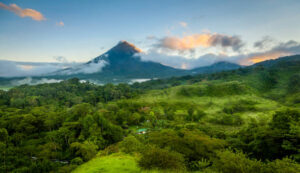
Costa Rica’s rainforests are teeming with an incredible variety of plant and animal species. From vibrant tree frogs and sloths to colourful birds like toucans and resplendent quetzals, these forests offer a captivating display of wildlife. The lush green canopies and cascading waterfalls add to the enchanting allure of these natural wonders.
Conservation efforts in Costa Rica have resulted in the establishment of numerous national parks and protected areas, ensuring the preservation of these vital ecosystems. The country’s commitment to sustainable tourism and eco-friendly practices allows visitors to explore and appreciate the rainforests while minimizing their impact on the environment.
Moreover, the Costa Rican rainforests play a crucial role in maintaining the country’s water resources, regulating climate patterns, and providing essential ecosystem services. They are also home to indigenous communities whose traditional knowledge and connection to the land contribute to their conservation efforts.
The Costa Rican rainforests serve as valuable educational and research sites, attracting scientists and nature enthusiasts from around the world. Through scientific studies and community involvement, ongoing efforts are being made to protect these precious habitats and ensure the long-term sustainability of Costa Rica’s rich natural heritage.
Papua New Guinea Rainforest:
The rainforests of Papua New Guinea, located in the southwestern Pacific, are a testament to the country’s astonishing natural beauty and biodiversity. These rainforests are considered one of the most ecologically diverse regions on the planet, harbouring an incredible array of plant and animal species found nowhere else on Earth.
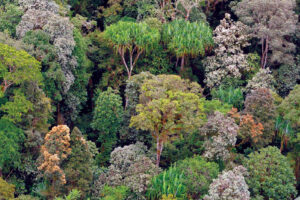 Papua New Guinea’s rainforests are home to iconic and unique wildlife, such as the renowned birds of paradise, tree kangaroos, and cassowaries. The lush canopies and pristine rivers create a breathtaking landscape that captivates visitors.
Papua New Guinea’s rainforests are home to iconic and unique wildlife, such as the renowned birds of paradise, tree kangaroos, and cassowaries. The lush canopies and pristine rivers create a breathtaking landscape that captivates visitors.
These rainforests play a vital role in maintaining the ecological balance of the region. They act as carbon sinks, helping mitigate climate change by absorbing and storing carbon dioxide. Additionally, they provide essential ecosystem services, including regulating water flows, protecting watersheds, and sustaining the livelihoods of indigenous communities.
However, the Papua New Guinea rainforests face significant threats from unsustainable logging practices, mining operations, and habitat fragmentation. These activities not only endanger the extraordinary biodiversity but also disrupt the cultural heritage and traditional way of life of indigenous communities.
Conservation efforts, including the establishment of protected areas and sustainable land-use practices, are crucial to safeguard the Papua New Guinea rainforests. Preserving their unique biodiversity and respecting the cultural significance they hold is vital for the sustainability and resilience of this invaluable natural treasure.
Madagascar Rainforest:
The rainforests of Madagascar, located off the southeastern coast of Africa, are a unique and captivating ecological wonder. As one of the world’s biodiversity hotspots, Madagascar’s rainforests harbour an astonishing array of plant and animal species found nowhere else on Eart
 Madagascar’s rainforests are characterized by their distinct flora, including iconic baobab trees, vibrant orchids, and unusual spiny forests. They are home to a diverse range of wildlife, such as lemurs, chameleons, and a multitude of bird species. Exploring these rainforests unveils a world of endemic species and ecological marvels.
Madagascar’s rainforests are characterized by their distinct flora, including iconic baobab trees, vibrant orchids, and unusual spiny forests. They are home to a diverse range of wildlife, such as lemurs, chameleons, and a multitude of bird species. Exploring these rainforests unveils a world of endemic species and ecological marvels.
The rainforests of Madagascar also hold immense cultural significance, with indigenous communities deeply connected to the land and its resources. Traditional practices and beliefs are intertwined with the conservation of these precious ecosystems.
However, Madagascar’s rainforests face significant threats, including deforestation, slash-and-burn agriculture, and illegal logging. These activities jeopardize the unique biodiversity and ecological balance of the rainforest, as well as the livelihoods of local communities.
Conservation efforts, both within Madagascar and through international collaboration, aim to protect and restore the rainforests. Establishing protected areas, promoting sustainable land-use practices, and raising awareness about the importance of preserving these fragile ecosystems are crucial steps in ensuring the long-term survival of Madagascar’s rainforests and their extraordinary biodiversity.
Yasuni National Park:
Yasuni National Park, located in the heart of the Ecuadorian Amazon, is a pristine rainforest and one of the most biodiverse regions on Earth. It spans an area of approximately 9,820 square kilometres (3,800 square miles) and is home to an extraordinary array of plant and animal species.
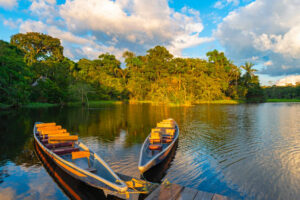
Yasuni National Park boasts an astounding variety of wildlife, including jaguars, giant river otters, toucans, and countless insect species. It is also renowned for its rich cultural heritage, with indigenous communities living in harmony with the rainforest for centuries.
This unique rainforest plays a vital role in maintaining the global climate balance. It serves as a carbon sink, storing significant amounts of carbon dioxide and contributing to the mitigation of climate change. Additionally, the park’s rivers and wetlands support essential ecosystems and provide habitats for aquatic species.
Despite its ecological significance, Yasuni National Park faces threats from deforestation, oil extraction, and illegal activities. Conservation efforts aim to protect the park’s biodiversity, preserve indigenous cultures, and promote sustainable development alternatives.
Preserving Yasuni National Park is of utmost importance for the planet’s biodiversity and the well-being of local communities. It serves as a shining example of the critical need to balance conservation and sustainable development in fragile rainforest ecosystems.
Olympic National Park:
Olympic National Park, located in the state of Washington, USA, is a diverse and stunning natural wonder. This expansive park covers nearly one million acres, encompassing a wide range of ecosystems. It is renowned for its breathtaking mountain ranges, old-growth forests, pristine coastline, and stunning alpine meadows.
 Within Olympic National Park, visitors can explore the snow-capped peaks of the Olympic Mountains, hike through ancient temperate rainforests, wander along picturesque rivers and lakes, and enjoy the rugged beauty of the Pacific coastline. The park is also home to a remarkable variety of wildlife, including elk, black bears, mountain goats, and bald eagles.
Within Olympic National Park, visitors can explore the snow-capped peaks of the Olympic Mountains, hike through ancient temperate rainforests, wander along picturesque rivers and lakes, and enjoy the rugged beauty of the Pacific coastline. The park is also home to a remarkable variety of wildlife, including elk, black bears, mountain goats, and bald eagles.
Preserving Olympic National Park’s ecological integrity is a priority, and it has been designated both a UNESCO World Heritage site and an International Biosphere Reserve. The park offers numerous recreational opportunities, from hiking and camping to wildlife watching and scenic drives, allowing visitors to immerse themselves in the splendour of this natural paradise.
In conclusion, the top 10 rainforests in the world showcase the awe-inspiring beauty and ecological significance of these remarkable ecosystems. From the majestic Amazon Rainforest to the enchanting Daintree Rainforest, each rainforest is a haven of biodiversity, supporting unique plant and animal species. However, these rainforests face numerous threats, including deforestation and habitat loss. It is crucial for us to recognize the importance of these invaluable ecosystems and take proactive measures to conserve and protect them. By preserving these rainforests, we not only safeguard our planet’s natural heritage but also contribute to the well-being of local communities and the global fight against climate change.


